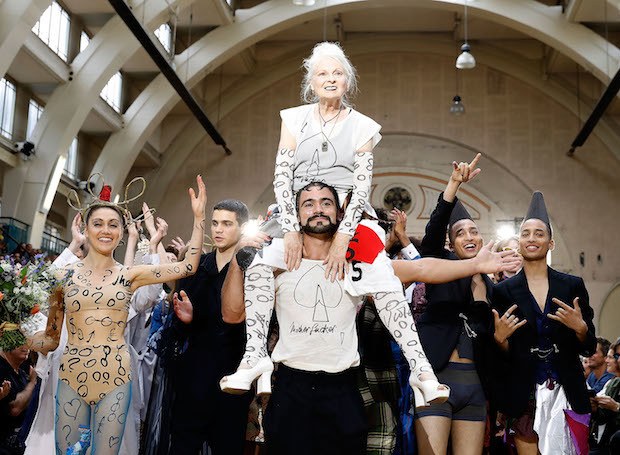This is a golden age for documentaries, if you have time to view them. Digital film and editing have reduced the cost of making a documentary, and online streaming has resolved the problem of distribution. The result is a glut of documentaries, generally well-made, and generally too long. Lorna Tucker’s Westwood: Punk, Icon, Activist comes in at eighty minutes. This is the same as a movie like Run, Lola, Run, and only slightly less than Paths of Glory (88 mins), The Producers (88 mins) and Stand By Me (89 mins).
Westwood is a self-made character, the Edith Sitwell of British fashion, and her biography has the plot twists and characters of fiction. Eighty minutes might not be long enough to do justice to Westwood’s talent and influence, or to explain how fashion, the quintessence of triviality and shallowness, can also be art, or at least artisanal. Yet Tucker’s documentary never explains what makes Westwood run; why she risked beggary and ridicule in the Seventies and Eighties to produce clothes that touched the sublimities of eroticism and comedy, often, in the English way, in the same garment; and what makes people stand by her, when she has little business sense or patience or, despite her efforts, not much quality control.
Westwood is an uncooperative subject. Having designed an improved version of herself, she is unwilling to expose the offcuts of origins and motivations from which she compiled her image. ‘I don’t know if I want to show any of this shit,’ she says as she prepares a collection for the catwalk. ‘I don’t know what I’m doing. It’s just a mess. It’s my fault.’
Born a grocer’s daughter in northern England in 1941, Westwood admits to an early encounter with a painting of the Crucifixion—‘You have to cut a figure, be prepared for action’—but says nothing more about her early life, other than that she was ‘so working class’ that she left art school after one term in order to ‘earn a living’. Married at twenty and a mother at twenty-one, she surmised that the housewife’s lot was ‘a lot of old bollocks’. ‘I was stupid,’ she said, ‘and had to discover what was going on in the world’. Her guide was the unreliable but astute Malcolm Maclaren, with whom she had a son in 1967.
Maclaren loved Fifties’ rock’n’roll and pin-ups. Westwood, while working as primary schoolteacher, ran up Maclaren’s designs on her sewing machine. In 1971, they rented the back half of a shop at World’s End, at the wrong end of the King’s Road. The shop changed its name whenever it changed its look. Let It Rock had pastiches of Teddy Boy drapes. Too Fast To Live, Too Young To Die was The Wild One and Gene Vincent. And then, in 1974, came the invention of Sex, inspired by Maclaren’s ambition, partly Situationist and profoundly sensationalist, to ‘confront the Establishment through sex’, with sales pitches like ‘Rubberwear for the office’.
All good dirty fun, and all likely to have been forgotten as just another Situationist prank, had not Maclaren also aspired to the music business. In 1975, after failing to manage the New York Dolls, he shaped The Sex Pistols from the grubby clay of two Sex customers, drummer Paul Cook and guitarist Steve Jones, and the shop’s Saturday boy, bassist Glen Matlock. Soon afterwards, John Lydon wandered in wearing a torn t-shirt with ‘I hate’ written above ‘Pink Floyd’.
‘We invented punk,’ Westwood claims. Of course they didn’t. The sound came from Detroit and New York. Much of the look can be traced back to the rock classicism that inspired Let It Rock. While Matlock, Cook and Jones awaited their Rotten in one Chelsea, The Ramones were fully formed in the other Chelsea. Consider Arturo Vega’s film of The Ramones in February 1975.
https://www.youtube.com/watch?v=r8DAme8kRak
Everything is there: the leather look, the three-chord nostalgia, even the dubious fetish for ‘shocking’ Nazi references. Westwood and Maclaren’s ‘invention’ was to assemble a genuine phenomenon into a stylistic and commercial package. So much for ‘anarchy’.
Did Maclaren invent Westwood? She admits that he was ‘gold’, and that he ‘knew the world’ that she wanted to join. The recurring elements of her style—punkish shreds of linen, the frills of highwaymen, pirates and doxies, hostile variations on patriotic fabrics like tweed and tartan, and random African make-up— were all in place before Westwood split from Maclaren. If those elements sound like the trappings of a video by one of Maclaren’s more successful post-Pistols efforts, Adam and the Ants, it is because that is exactly what they were.
Yet Westwood, like John Lydon, outgrew her Svengali. Maclaren was not happy about this. The film alleges that in the mid-Eighties, after their marriage had broken up, he blocked Westwood’s attempt to finance her business with Italian investors, by claiming he had a right to half of Westwood’s business. Tucker never establishes if this was the case. Nor does she probe Westwood on daft assertions like, ‘We don’t have any democracy in England’; or on whether she regrets profiting from the use of the Nazi imagery as a fashion statement; or on the disjuncture between her support of the Green Party and Jeremy Corbyn’s Labour and her company’s use of a Luxembourg-based shell company to reduce its UK tax liabilities. This may be the fashion business, but it would be interesting to get even a little below the surface.
We do learn how Westwood collaborates on her designs with her much younger and very camp second husband, Andreas Kronthaler, who surely inspired Sacha Baron Cohen’s Bruno. She has an idea, and he assembles it. A model wears the rough design, and further additions are made in an almost sculptural process. Westwood is serious about her art and her business without succumbing, at least on matters non-environmental, to the cheek-sucking, po-faced idiocy of the fashion world. But while contrived artlessness is the secret of her success—the film shows how much thought and care goes into each piece of cloth—it also blinds her to self-knowledge, and perhaps also to knowledge of ‘the world’. Westwood, a vocal environmentalist and anti-capitalist, is the proprietor of a fashion multinational. She wants to keep the business manageable, but seems genuinely surprised to discover that her shops are selling plastic shoes along with environmentalist messaging.
Tucker does, though, hint that Westwood, who made ‘cash from chaos’ with Maclaren in the punk years, cannot function without disorder, personal and stylistic as well as political-gestural. When managers from her 120 shops fly in from every corner of the world to Paris, for ‘presentation’ of the new season’s designs, the employee charged with making the sales pitch has vanished. Westwood, just as she did on her sewing machine when she started in the Seventies and restarted in the Eighties, has to do the work herself.
Dominic Green is Culture Editor of Spectator USA.
















